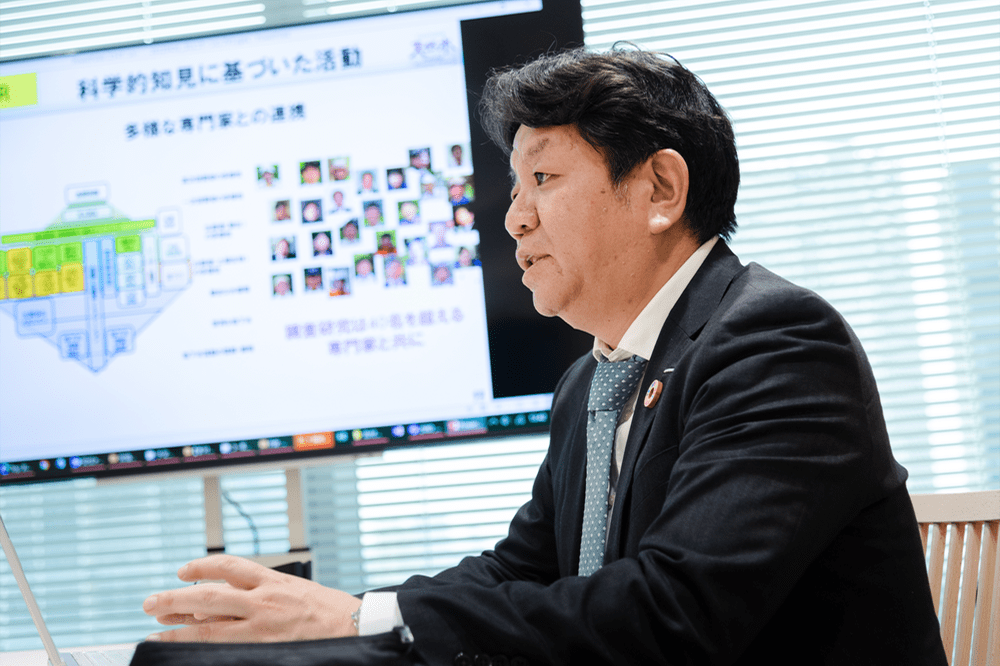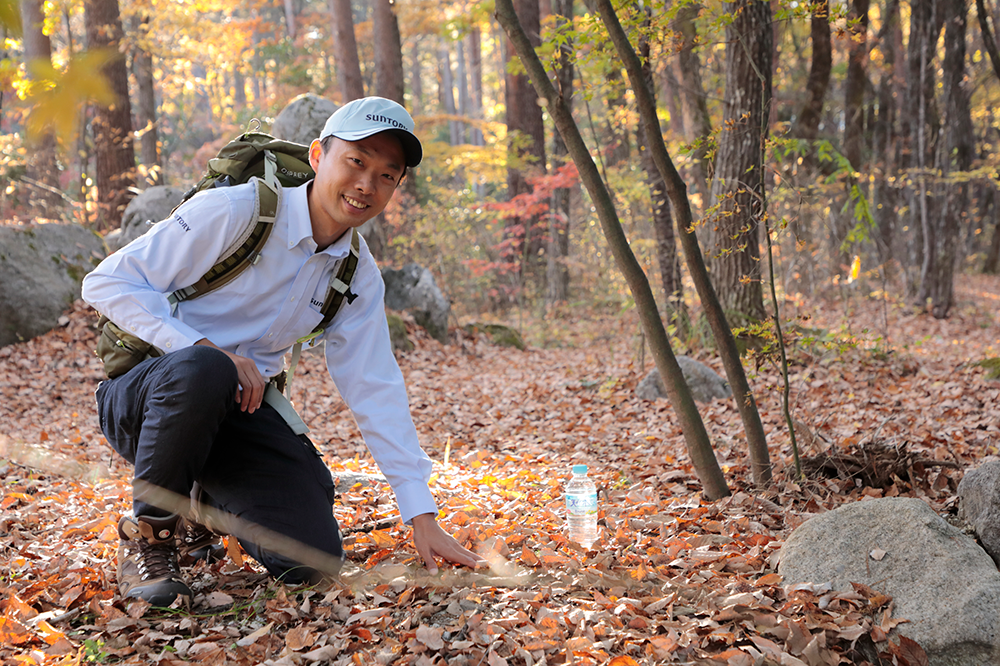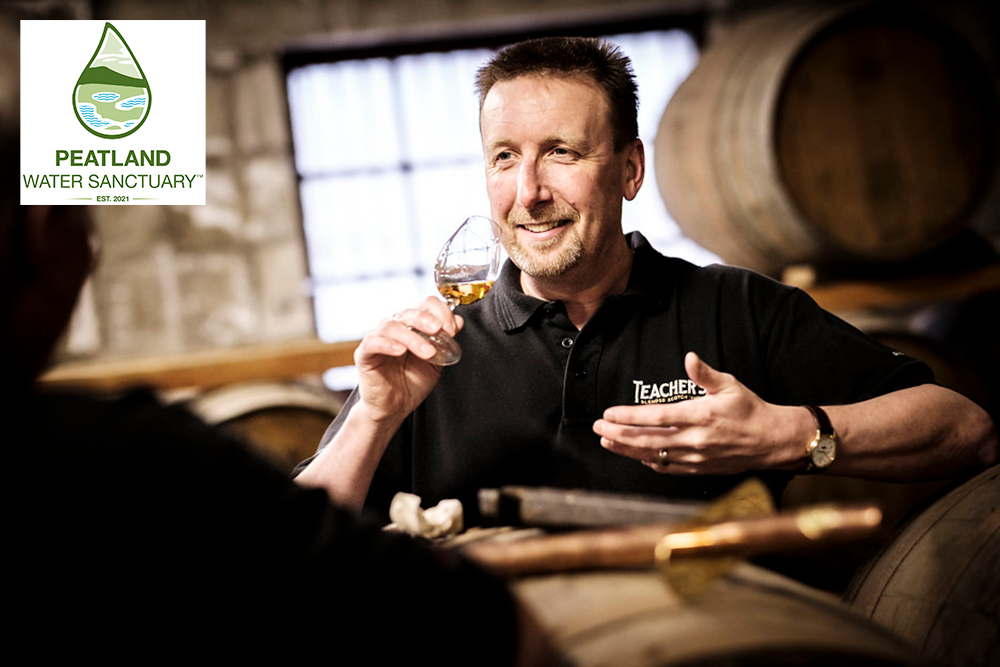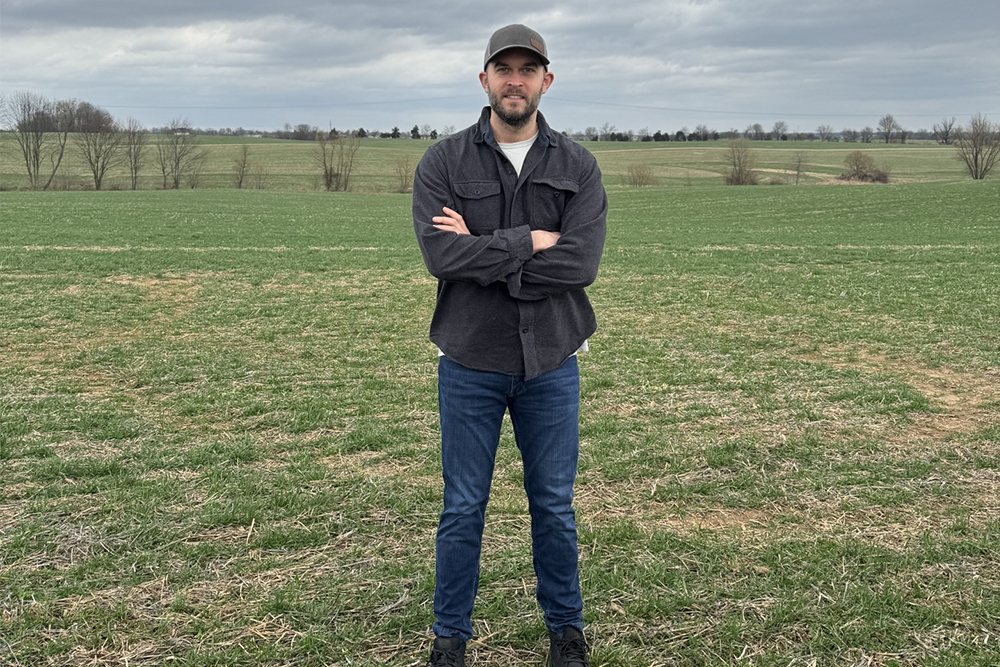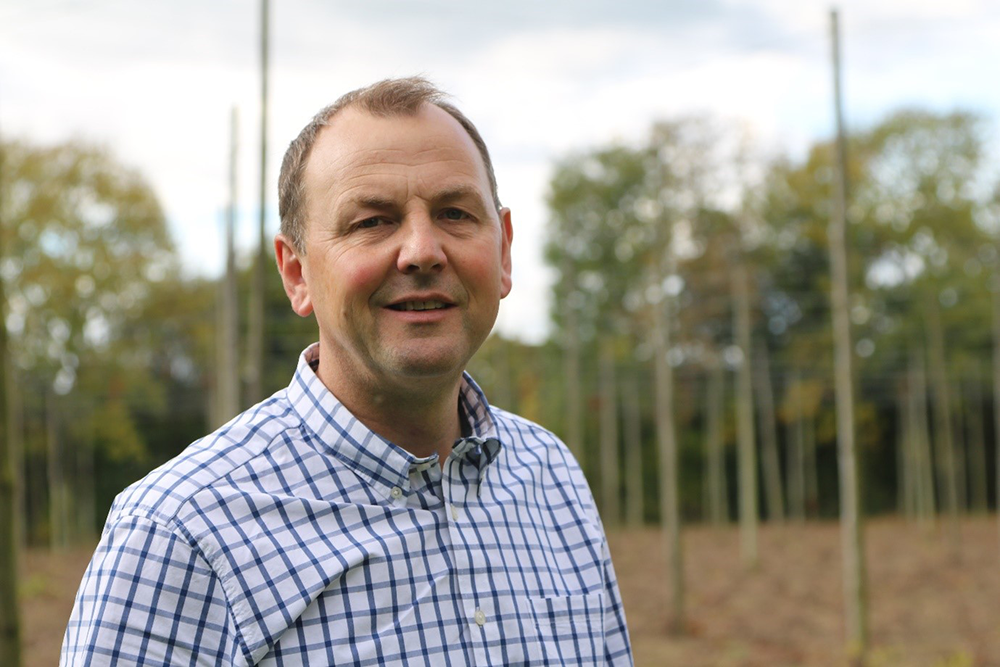Our Journey as a Company that Creates Harmony with People and Nature
As a multifaceted beverages company, Suntory Group delivers the blessings of water and nature to customers through our products. Beautiful, clean water, plants and forests that grow in rich soil, rivers, oceans, and the air, and ecosystem services created by living creatures are the very foundation of Suntory Group's business. We recognize that safeguarding, carefully using, and circulating these gifts of nature is not only a crucial responsibility, but also a lifeline for business continuity.
More than 50 years ago, in 1973, Suntory Group began its bird conservation activities with the slogan "Today Birds, Tomorrow Humans" (the happiness that comes to birds today may bring happiness to humans tomorrow). These activities seek to raise awareness of the environment through wild birds, which are said to be a barometer of the environment, and to pass on to future generations an environment in which birds, people, and all other living things can live in abundance.
In 2003, the Suntory Natural Water Sanctuaries were launched in Kumamoto, Kyushu, with the aim of improving water replenishment functions and restoring biodiversity. They have since been expanded to cover an area of more than 12,000 hectares in 26 locations across 16 prefectures*, and are now conserving and restoring more than twice the amount of groundwater withdrawn by our plants in Japan. Currently, efforts to coexist with nature, such as water conservation activities, are expanding in various parts of the world where we do business.
*As of July 31, 2025
In recent years, initiatives for nature-positive practices have been accelerating, marked by the adoption of the Kunming-Montreal Global Biodiversity Framework at the 15th Conference of Parties to the UN Convention on Biological Diversity (COP15) in 2022.
In 2023, Suntory Group was the only Japanese company to participate in the world's first pilot of corporate guidance for nature conservation by the Science Based Targets Network (SBTN), and in September of the same year, we used the analysis results from the pilot to make a pilot disclosure to the Taskforce on Nature-related Financial Disclosures (TNFD).
In line with the recommendations of the TNFD and the Task Force on Climate-related Financial Disclosures (TCFD), we have disclosed Suntory Group's integrated environmental management initiatives.

First “Save the Birds! Campaign” newspaper ad (1973)

To contribute more effectively to addressing the deeply interrelated challenges of climate change, biodiversity, water security and resource circulation, comprehensive measures are essential. Nature-related activities such as our Natural Water Sanctuaries represent initiatives that involve collaboration with many stakeholders with the aim of resolving complex environmental issues.
Suntory Group will continue to contribute to the realization of "Nature Positive" and "Net Zero" consistent with globally shared standards based on science.
| History of Suntory Group’s nature Initiatives | Spread and impact of activities to date | |
|---|---|---|
| 1973 |
|
|
| 2003 |
|
|
| 2004 |
|
|
| 2022 |
|
|
| 2023 |
|
|
- Suntory Bird Conservation Activities

- Suntory Natural Water Sanctuary

- Suntory Mizuiku - Education Program for Nature and Water

Context and Scope of this Disclosure
Context of this Disclosure
- The material issues identified through our materiality analysis – namely water, climate action, containers and packaging, and raw ingredients - are all interrelated and mutually influential. Accordingly, we disclose information on these topics in an integrated manner in accordance with individual disclosure frameworks such as the TNFD and TCFD recommendations.
- Suntory Group was the only Japanese company to participate in the corporate guidance pilot announced in 2023 by SBTN. Of the steps in the LEAP (Locate, Evaluate, Assess, Prepare) approach, which is part of the TNFD framework, for steps L and E, we utilize the results of the analysis of direct operations and upstream value chains in SBTN’s Steps 1 and 2. Please see the diagram below for the correlation between the TNFD and SBTN approaches.
Linkage between TNFD and SBTN

Scope of Disclosure
- Suntory Group's main businesses are covered: (1) beverages and food-related businesses, (2) alcoholic beverage business, and (3) other businesses
- Specifically, Suntory Group's entire value chain for the following businesses is covered in the scope:
- (1)Beverage and food business: Suntory Beverage & Food Ltd.
- (2)Alcoholic beverage business: Suntory Spirits Ltd. and Suntory Global Spirits Inc.
- (3)Other businesses: Suntory Wellness Ltd., etc.
Areas with Material Nature and/or Climate Related Issues
- With regard to nature, the assessment covers 79 directly operated production sites (27 in Japan and 52 outside of Japan), and the countries from which the 8 main raw ingredients are procured upstream in the value chain.
- Regarding climate change, the assessment covers our own sites and areas related to the upstream and downstream of our value chain.
Governance
Suntory Group adopts a holding-company system. The Board of Directors for Suntory Holdings, the holding company, consists of 9 directors, including 1 outside director (as of April 1, 2025). The Board of Directors is responsible for discussing, deliberating and makes decisions regarding management issues affecting the entire Group while supervising the execution of operations by all Group companies. The introduction of an executive officer system has separated the business decision-making process from the execution of business operations, enabling swift and agile decision-making.
In response to the expansion of global business of the Group, Suntory Holdings established the Global Risk Management Committee (GRMC) for enterprise risk management (ERM), covering sustainability-related risks, in order to strengthen the risk management promotion framework for the entire Group including international Group companies. We also established the Global Sustainability Committee to discuss sustainability strategies and manage progress toward our goals.
The Global Risk Management Committee is chaired by the executive officer in charge of risk management, with the heads of risk management for key business areas serving as vice chairs. Executive officers responsible for major functional areas also participate as members. Under this Global Risk Management Committee, we have established risk management committees and risk management teams at major operating subsidiaries to collaborate on identifying and managing significant risks across Suntory Group. The Global Risk Management Committee meets quarterly to advance activities such as identifying risks across Suntory Group, monitoring countermeasures, and establishing crisis management frameworks. Nature-related risks and climate change-related risks are identified as some of the most important risks, and the Committee actively discusses and monitors the measures to address these risks.
The Global Sustainability Committee is chaired by the executive officer in charge of sustainability and vice-chaired by executive officers from key business areas. Members of the committee include executive officers in charge of major functional departments, heads of domestic and international operating companies, and functional department heads. The Global Sustainability Committee discusses mid- to long-term business strategies of Suntory Group companies and businesses, focusing on the 7 sustainability themes outlined in Suntory Group's Sustainability Vision, including initiatives related to nature and climate change.
The Global Risk Management Committee and the Global Sustainability Committee maintain continuous collaboration. Important decision-making matters are further discussed, deliberated, and resolved by the Board of Directors. The Global Risk Management Committee and the Global Sustainability Committee each handle as agenda items and review the progress of sustainability strategies, identification of risks and opportunities, and exploring risk mitigation, avoidance, transfer and acceptance methods. They report regularly to the Board of Directors, which discusses and oversees sustainability strategy policies and plans. In particular, with regard to sustainability-related risks that have been assessed as the Group's most significant risks through the Global Risk Management Committee's enterprise risk management (ERM), the Global Sustainability Committee discusses countermeasures and reports the status of countermeasures to the Global Risk Management Committee. In addition, the Global Sustainability Committee deliberates the analysis results of the materiality based on the risks identified through enterprise risk management (ERM), and receives approval from the Board of Directors.
<Main Sustainability Matters Reported and Resolved by the Board of Directors (2024)>
- Revisions to the Suntory Group Human Rights Policy
- Revisions to water targets in Environmental Targets toward 2030
- Progress Report for Environmental Targets toward 2030
The Board of Directors are provided with opportunities to receive advice on sustainable management through events such as periodic seminars with external expert guests. Additionally, the criteria used to determine executive compensation include specific sustainability items.
Of the materiality, with regard to "climate action," "containers and packaging," and "human rights," we hold the GHG Scope 3 Reduction Promotion General Meeting, the Containers and Packaging Task Force, and the Human Rights Working Team Meeting, as forums for discussing more specific strategies and initiatives, primarily with working level staff from key businesses and functional departments.
The GHG Scope 3 Reduction Promotion General Meeting, under the relevant functional departments and the corporate planning departments of key businesses, drives the reduction of Scope 3 emissions toward the achievement of Suntory's Environmental Targets toward 2030. Specifically, it has formulated a roadmap for reducing Scope 3 emissions and discusses the challenges and strategies to ensure the effective implementation of key measures for Scope 3 emissions reduction.
The Containers and Packaging Task Force consists of the executive officer in charge of sustainability, the executive officer in charge of public relations, and the heads of relevant functional departments (such as sustainability, innovation, corporate planning, finance, legal, intelligence, and manufacturing). It meets for the purpose of formulating plans and managing progress toward achieving the 2030 targets for containers and packaging. Specifically, in addition to discussing the direction of efforts to address issues concerning plastics, the task force discusses the formulation of a roadmap for achieving the 2030 target for sustainable PET bottles, as well as the progress of agreements on "bottle to bottle" horizontal recycling that have been concluded with local governments and companies in Japan.
In the area of human rights, we have the Human Rights Working Team that consists of personnel from functional departments such as sustainability, supply chain, human resources, legal, and compliance, as well as sustainability personnel from major operating companies. The team holds monthly discussions across divisions to promote human rights due diligence, including sharing domestic and international information on human rights, identifying and responding to risks of human rights abuse throughout the value chain, and conducting activities to raise awareness.
Organizational Chart

| Roles and authorities | Members | Meetings per year | Main Deliberations in 2024 | ||
|---|---|---|---|---|---|
| Board of Directors |
|
|
At least 12 times/year |
|
|
| Global Risk Management Committee |
|
|
4 times/year |
|
|
| Global Sustainability Committee |
|
|
Around 6 times/year |
|
|
| Promotion bodies for materiality | GHG Scope 3 Reduction Promotion General Meeting |
|
|
3 times/year |
|
| Containers and Packaging Task Force |
|
|
Every other month |
|
|
| Human Rights Working Team |
|
|
Monthly |
|
|
Strategy
To promote sustainable management that takes into account the changes which can be anticipated in the macro environment over the mid to long term, Suntory Group has identified its materiality relevant to the Group and integrated them into our sustainability strategy.
In 2023, using the concept of double materiality, we sought to identify and evaluate the impact on Suntory Group’s finances and our external impacts on the environment and society.
Based on the results of the materiality analysis, the Suntory Group Sustainability Vision was also revised in the same year.
The 7 key themes in the Suntory Group Sustainability Vision consist of "Nature" (water, containers and packaging, climate action, and raw ingredients) and "People" (health, human rights, and lifestyle). Suntory Group is mindful of the interdependent relationship between "Nature" and "People," and is working with stakeholders to create a society in which both "Nature" and "People" resonate harmoniously.
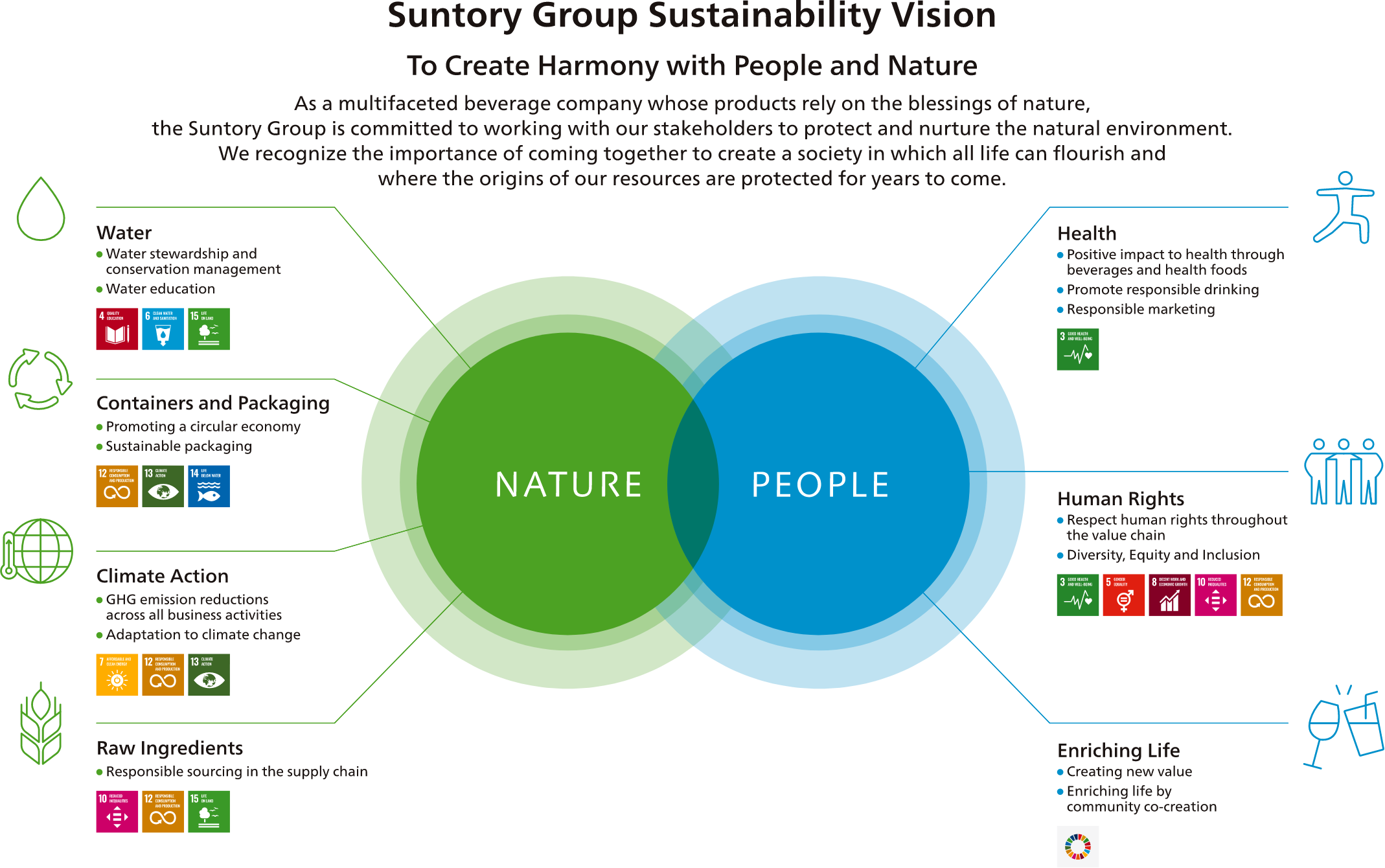
Click here for details on the process of identifying Suntory’s materiality.
Suntory’s Sustainable Management Suntory Group’s Sustainability Suntory
Policy on the Environment
As a company that embraces "Sustained by Nature and Water" as our corporate message, Suntory Group recognizes the Earth’s environment itself as a vital foundation of our business operations.
Suntory Group Environmental Principles, our highest-level environmental policy, defines our policy for the 5 key issues of achieving water sustainability, conserving and regenerating biodiverse ecosystems, promoting a circular economy, transitioning to a net zero-carbon society, and engaging with society.
With regard to "water sustainability," we share our Sustainable Water Philosophy throughout the Group in order to promote initiatives tailored to the water resource conditions in various regions around the world where we operate.
Additionally, plastic containers and packaging, which plays a significant role in Suntory Group's efforts to transition to a circular and net-zero society, is addressed under the Suntory Group Plastic Policy. Suntory Group collaborates with diverse stakeholders to tackle related challenges actively.
Furthermore, Suntory Group recognizes that environmental issues are deeply related to human rights issues. For this reason, we have established a of human rights due diligence framework based on the Suntory Group Human Rights Policy to identify, prevent and mitigate any potential adverse human rights impacts we may have on society. In regard to the rights of local community including indigenous peoples, which is one of the important themes in respecting human rights, we commit to respecting the rights of indigenous peoples and legitimate ownership rights regarding the ownership and use of land and natural resources, avoiding negative impacts on access to water, land, and natural resources, and implementing "Free, Prior, and Informed Consent (FPIC)" when acquiring water, land, and natural resources.
Our commitment to the above policies is shared with our suppliers through the Suntory Group Basic Policy on Sustainable Procurement and the Suntory Group Partner Guidelines, and measures are implemented collaboratively.
Policy and Guidelines
- Suntory Group Environmental Principles (Established in 1997 and revised in 2022)
- Suntory Group Sustainable Water Philosophy (Established in 2017)
- Suntory Group Plastic Policy (Established in 2019)
- Suntory Group Human Rights Policy (Established in 2019 and revised in 2024)
- Suntory Group Basic Policy on Sustainable Procurement (Established in 2011)
- Suntory Group Green Procurement Standard (Established in 2011)
- Suntory Group Partner Guidelines (Established in June 2017 and revised in May 2023)
Identification Process for Nature-Related Dependencies, Impacts, Risks and Opportunities
To further improve the accuracy of the assessment of the impacts and dependencies between our business and nature, Suntory Group has used tools and databases recommended by SBTN to clarify the pressure that Suntory Group exerts on nature and the ecosystem services on which its business depends.
For direct operations, we classified and defined Suntory Group's key business activities to be assessed by selecting the economic activity classification of the International Standard Industrial Classification (ISIC) to which our business activities belong, and also used the Materiality Screening Tool (MST) developed by SBTN to gain an overview of the impact of our business activities on nature.
In the upstream value chain, we conducted an MST assessment of our main raw ingredients, and also used the HICL (High Impact Commodity List), which lists raw ingredients that are considered to have a large impact on nature by SBTN, to identify our raw ingredients that have a particularly large impact on nature. We also assessed the environmental and human rights impacts and nature conditions in major sourcing countries. (For more information, see the relevant section in Identification of Priority Sites Related to Nature below)
With regard to dependencies on nature, we used the online tool ENCORE (Exploring Natural Capital Opportunities, Risks and Exposure), jointly developed by international financial industry organizations in the field of natural capital, the United Nations Environment Programme World Conservation Monitoring Centre (UNEP-WCSC), and others, to gain an overview of dependencies.
Impacts on Nature

- *As these items are outside the scope of the SBTN, they were not included in the assessment of local conditions, the identification of priority locations and the risk/opportunity assessment.
Dependencies on Nature

The diagram below summarizes the pathway relationships based on the above-mentioned impacts and dependencies on nature.
Connections between nature-related dependencies and impacts and risks and opportunities – Impact and dependency pathways

Dependencies and Impacts on Nature in the Value Chain and Corresponding Measures

Identification of Priority Locations Related to Nature
Direct Operations
In identifying priority locations for our direct operations, we narrowed down the list from the perspectives of water usage and water quality based on findings gained from the pilot of guidance for companies provided by the Science Based Targets Network (SBTN), which we joined in 2023.
First, we analyzed the quantity and quality of available water resources in the watershed to assess the nature conditions on which the production site depends. The assessment used several indicators from Aqueduct 4.0 and the Water Risk Filter developed by the World Wide Fund for Nature (WWF).
For the volume of available water resources, we used the 3 indicators of Baseline Water Stress, Water Depletion, and Blue Water Scarcity, with the highest score taken as the risk score. Areas with high scores on these indicators indicate a high probability of water resources being strained relative to demand.
We assessed water quality using the 3 indicators of Coastal Eutrophication Potential, Nitrate-Nitrite Concentration, and Periphyton Growth Potential, with the highest score used as the risk score. Higher scores for each indicator show greater exposure to eutrophication.
Furthermore, to assess the impact of our operations at production sites on watersheds, we normalized water usage and water pollutants contained in wastewater (weight equivalents of nitrogen and phosphorus) and compiled a list for each site. However, the assessment of water pollutants was limited to facilities that discharge wastewater directly into rivers, and excluded facilities that discharge wastewater via sewer systems. Next, to identify sites at high risk in terms of both dependencies and impacts on natural conditions, we multiplied the volume of available water resources by the normalized score for water usage and multiplied the score for water quality by the normalized score for water pollutants, and selected sites that were ranked in the top 10 watersheds as priority sites. Of the identified sites, based on an assessment using the Integrated Biodiversity Assessment Tool (IBAT) and multiple biodiversity indicators, we identified sites that are close to protected areas and key biodiversity areas within a 20 km radius and are expected to have relatively high levels of biodiversity vulnerability and difficulty in restoring them.
Number of High Priority Locations
| Number of High Priority Sites | Non-alcoholic beverage | Alcoholic beverage | Others | |
|---|---|---|---|---|
| Number of locations with high water-resource dependency and impact risk | 9 | 4 | - | |
| Of these, locations with a large effect on biodiversity | 3 | 3 | - | |
| Number of locations with high water-quality dependency and impact risk | - | 15 | 3 | |
| Of these, locations with a large effect on biodiversity | - | - | - | |
From the perspective of water management (water withdrawal and water-saving) and water replenishment and conservation through coexistence with the communities, we assessed the level of actions taken by identified priority sites to reduce risks and confirmed the progress. Since the condition of the water resource is different in each watershed where our sites are located, we conduct measures to reduce risks that correspond with local conditions.
For more information on water risk assessment, see below.
Water Risk Assessment Suntory Group’s Sustainability Suntory
Upstream Value Chain (Procurement of Raw Ingredients)
We assessed the environmental and human rights impacts for 8 key raw ingredients (barley, coffee beans, corn, raw milk, green tea leaves, hops, oak wood, and sugar cane) and their main sourcing countries (covering 45 combinations of raw ingredients and sourcing countries).
The environmental and human rights impact assessments are based on secondary data and do not represent the impact of Suntory Group's business activities. The purpose is to verify the validity of our activities to date and to utilize the results as basic data for determining priorities for future initiatives.
<Scope and Method of Assessment>
| Scope of assessment | Data used | |
|---|---|---|
| Dependency level on raw ingredients/ sourcing country) | Concentration of Sourcing Countries | The market concentration index, the Herfindahl-Hirschman Index, was applied to the purchasing volume ratio of each raw ingredient to estimate the market concentration |
| Environmental Impact | Climate change | Emission factors for each supplier and raw ingredient used in the calculation of Scope 3 emissions by Suntory Group |
| Water usage | Water footprint by raw ingredient in various countries around the world (Report of UNESCO-IHE Institute for Water Education) |
|
| Pollution | Fertilizer usage by raw ingredient in countries around the world (IFASTAT) | |
| Land use | Cultivated area per unit yield of raw ingredients by country (FAO) | |
| Human rights Impact | (1) Child labor, (2) forced labor, (3) working hours, (4) fair wages and welfare, (5) discrimination, abuse, and harassment, (6) freedom of association and right to collective bargaining, (7) access to remedy, (8) health and safety | Commodity risk assessment provided by Verisk Maplecroft |
Heatmap of the Environmental and Human Rights Impacts of Main Raw Ingredients

- *N/A indicates that the item could not be assessed this time due to a lack of data
The results of this survey showed that coffee beans pose the highest risk in terms of both environmental and human rights impacts, and that, among the countries from which Suntory Group sources coffee beans, Brazil poses the highest risk. Suntory Group procures some of our produce from the “Fazenda Bau” farm in Brazil, which has received international sustainability certification, and is also promoting a program to support the farmers we source our produce from in collaboration with trading companies and local partners. As a result, we have confirmed the appropriateness of the direction of the current procurement strategy.
Additionally, the results showed that green tea leaves have a relatively high impact on the environment in terms of GHG emissions and water usage. Suntory Group is working with the Kuma Regional Agricultural Cooperative in Kumamoto Prefecture, a producer of green tea leaves, to introduce environmentally conscious processes in the tea leaf manufacturing process, thereby reducing GHG emissions by more than 30% compared to typical manufacturing processes. We will continue to consider further activities in the future.
Based on the amount of fertilizer used, 6 raw ingredients (barley, coffee beans, corn, green tea leaves, hops, and sugar cane) were identified as having a high impact of "soil contamination." For 4 of these materials (barley, coffee beans, corn, and sugar cane), Suntory Group is actively promoting sustainable agricultural practices, such as regenerative agriculture, and plans to continue expanding our activities in the future.
Through this survey, we were able to identify combinations of raw ingredients and supply source (country) that are generally high risk. Going forward, we will use these results to consider strategies that take into account field investigations and other pertinent information.
Financial Risks and Opportunities related to Climate Change and Nature
In examining future risks and opportunities, we assumed 2 scenarios for climate change and 1 scenario for nature, and assessed the financial impacts of each.
Climate Change Scenarios
| Scenario | 1.5℃ Transition scenario (RCP 2.6/SSP 1-1.9) |
3.0℃/4.0℃ Physical scenario (RCP 8.5/SSP 2-4.5) |
|---|---|---|
| Scenario context |
|
|
Nature Scenarios
As there are no normative scenarios for nature, Suntory Group has interpreted the 4 scenarios presented by TNFD and examined scenarios that we believe are appropriate for considering future risks and opportunities.
While Suntory Group aims to achieve Scenario 1 (Ahead of the Game) in which Nature Positive is successful, we also aim to test the resilience of our strategies by evaluating Scenario 2 (Go Fast or Go Home), in which physical and transition risks are deemed to be most severe, and we identified risks and opportunities and assessed their financial impacts.
Nature Scenarios

- *Some interpretation and modification from the TNFD Final Recommendation v1.0
List of Risks and Opportunities
Based on the scenarios set out above, we identified the key risks and opportunities related to climate change and natural capital and organized countermeasures. As a result, for physical risks, we were able to confirm that countermeasures are largely in place or under consideration. Additionally, in terms of responding to transition risks, we reaffirmed the need to closely monitor legislative trends and consumer preferences in countries around the world and flexibly develop response strategies.
With regard to opportunities, we will expand opportunities for business continuity through risk reduction and other measures, as well as opportunities for business growth by offering innovative products and services that capture consumer preferences.
Definition of Period in Which Risks and Opportunities Emerge
The periods in which risks and opportunities emerge are categorized as follows.
The mid-term period is based on our Environmental Targets toward 2030, while the long-term period is based on our Environmental Vision toward 2050.
- Short-term: Within 1 year from the assessment
- Mid-term: Period until 2030
- Long-term: Period until 2050
Financial Impact Assessment Criteria
The criteria for evaluating financial impact are unified with the enterprise risk management (ERM) criteria, and items with a medium to large financial impact are listed.
| Category | Subcategory | Main risks and opportunities | Correlation with natural capital and climate change | Value chain | Financial impacts | Risk emergence timeline | Countermeasures |
|---|---|---|---|---|---|---|---|
| Physical | Acute/Chronic | Shutdown of operations due to extreme weather (floods, tidal surge, storms, etc.) | Climate change | Direct operations | Medium to large | Short to medium |
|
| Physical | Chronic | Shutdowns due to water shortages caused by excessive water withdrawal in surrounding areas and increased droughts |
Natural capital Climate change |
Direct operations | Medium to large | Mid to long |
Water Risk Assessment Suntory Group’s Sustainability Suntory |
| Physical | Chronic | Increased costs for quality control and wastewater regulations due to deterioration of water quality in surrounding areas | Natural capital | Direct operations | Medium to large | Mid to long |
Water Risk Assessment Suntory Group’s Sustainability Suntory |
| Physical | Acute/Chronic | Decreasing crop yields and relocation of suitable cultivation areas leading to unstable procurement and higher procurement costs |
Natural capital Climate change |
Upstream | Medium to large | Mid to long |
Sustainable Procurement Suntory Group’s Sustainability Suntory |
| Transition | Policy | Higher cost due to introduction of carbon taxes | Climate change | Upstream/Direct operations | Medium to large | Mid to long |
|
| Transition | Policy | Increased costs from compliance with regulations regarding raw ingredients, containers, and packaging |
Natural capital Climate change |
Value chain Overall |
Medium to large | Mid to long |
|
| Transition | Markets | Revenue decline due to delayed response to shifting consumer preferences toward sustainable products |
Natural capital Climate change |
Direct operations | Medium to large | Mid to long |
|
| Transition | Reputation | Revenue decline resulting from criticism by NGOs and media regarding environmental and social issues |
Natural capital Climate change |
Direct operations | Large | Mid to long |
|
| Opportunity | Enhancement of brand value through increased public recognition of the company’s commitment to responsible water stewardship |
Natural capital Climate change |
Downstream | Large | Short to long |
|
|
| Opportunity | Revenue growth driven by the capture of new market and income opportunities. |
Natural capital Climate change |
Downstream | Large | Mid to long |
|
|
Of the identified risks and opportunities, we estimated the financial impact from a climate change perspective for 3 points: "Shutdowns due to water shortages caused by excessive water withdrawal in surrounding areas and increased droughts," "Higher cost due to introduction of carbon taxes," and "Decreasing crop yields and relocation of suitable cultivation areas leading to unstable procurement and higher procurement costs."
| Risk | Financial impact amount | Approach and method of calculation |
|---|---|---|
| Shutdowns due to water shortages caused by excessive water withdrawal in surrounding areas and increased droughts | Lost opportunity cost: 26.0 billion yen (2030 and 2050/3℃ and 4℃ scenarios) |
Estimated the cost impact assuming a 1 month water withdrawal restriction at all of our plants located in areas with high water stress (Exchange rate assumption: 1 US dollar = 146 Japanese yen) |
| Higher cost due to introduction of carbon taxes |
2030: production costs set to increase by 19.0 billion yen 2050: production costs set to increase by 35.0 billion yen (1.5℃ scenario) |
Calculated based on our 2019 emissions (Scope 1 and 2) using the IEA NZE carbon tax price forecast
|
| Decreasing crop yields and relocation of suitable cultivation areas leading to unstable procurement and higher procurement costs |
2030: procurement costs set to increase by 5.9 billion yen 2050: procurement costs set to increase by 8.0 billion yen (*) (3℃ and 4℃ scenarios) |
Using a scientific data-based climate change impact calculation tool, we grasped the impact on agricultural yields and calculated the cost impact based on the assumption of increased raw ingredient prices and usage amounts (Exchange rate assumption: 1 US dollar = 146 Japanese yen) |
(*) Yield Impact on Key Raw Ingredients and Their Production Areas Under a 4℃ Scenario by 2050
| Business Sector |
Raw material | North America |
Latin America |
Asia | Europe/Africa | Oceania |
|---|---|---|---|---|---|---|
| Alcoholic and non-alcoholic beverage |
Barley* | Canada Yield: |
UK Yield: France Yield: |
|||
| Alcoholic and non-alcoholic beverage |
Corn* | USA Yield: |
Brazil Yield: |
China Yield: |
||
| Alcoholic and non-alcoholic beverage |
Sugarcane* | Brazil Yield: |
Thailand Yield: |
Australia Yield: |
||
| Alcoholic beverage |
Oak | USA Wood quantity: |
Japan Suitable land : |
Spain Suitable land : |
||
| Alcoholic beverage |
Hop | USA Yield: |
Germany Yield: Czech Yield: |
|||
| Non-alcoholic beverage |
Coffee beans | Brazil Yield : Colombia Yield : Guatemala Yield : |
-
*Include origin of processed ingredient
As shown in figure below, based on the analysis at the end of July 2025, the total business impact of the 4°C scenario as of 2050 is projected to be a positive 8.0 billion yen. Prices of coffee beans, oolong tea leaves, corn, and barley are projected to rise due to falling output, raising procurement costs. At the same time, sugarcane and sugar beet prices are projected to decrease on higher output, resulting in a positive business impact.
Impact on Procurement Costs of Key Raw Ingredients in the 2050 4°C Scenario
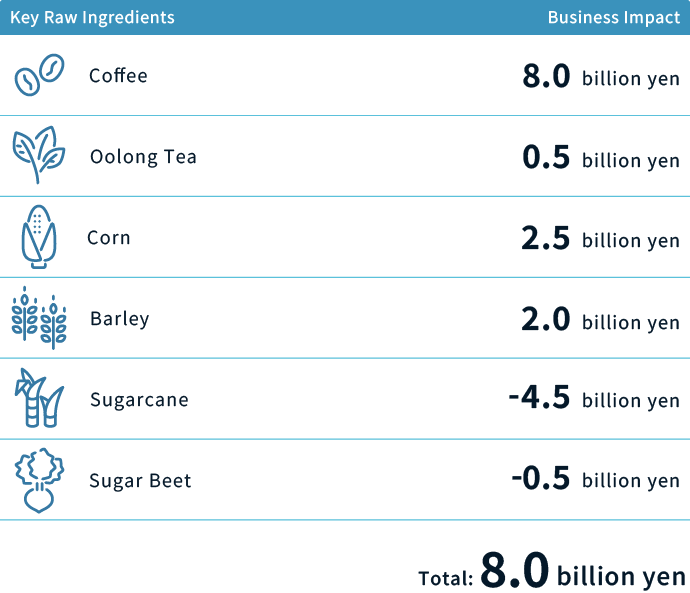
-
*Scope of company: Suntory Global Spirits Inc., Suntory Beverage & Food Limited, Suntory Spirits Ltd.
-
*Currency exchange rate 1USD=146 JPY
-
*For corn, calculations included alcoholic beverage and food use, including processed raw ingredients
-
*For barley, calculations were made for alcoholic beverage use only
Suntory Group’s Initiatives for Nature and Climate
Since nature and climate are interrelated and affect each other, taking an integrated approach to address both issues is more effective. We also consider the impact of each initiative on local communities, business partners, customers, and others, believing it is important to maximize the effectiveness of initiatives by collaborating with other private sector companies and government agencies, not to mention through appropriate engagement with stakeholders.
We have recently organized the nature and climate-related initiatives being undertaken by Suntory Group and linked the impact on nature to the AR3T Framework presented by SBTN, as well as the elements of the Engagement Strategy in the framework on climate transition planning published by the Transition Plan Taskforce (TPT) and the discussion paper on nature transition planning published by the TNFD.
As a result, we were able to confirm that our materiality is being addressed while taking into consideration important stakeholders. As we move forward with further nature and climate transition plans, we recognize the need to take into account a "just transition," and will consider steps for this transition, such as engaging with stakeholders in raw ingredient producing regions.
Going forward, we will consider additional initiatives that Suntory Group should undertake in line with the frameworks of various transition plans.
AR3T Framework

Main Initiatives in the Transition Plan
| Materiality | Key Initiatives in Transition Plan | Action to Climate Change | Action to Nature (AR3T framework) |
Engagement Strategy | |||||||
|---|---|---|---|---|---|---|---|---|---|---|---|
| Mitigation | Adaptation | Avoid | Reduce | Restore and regenerate | Transform | Community | Value Chain | Industry | Policy | ||
| Water sustainability |
Water replenishment and conservation | ● | ● | ● | ● | ● | ● | ||||
| Water conservation at own plants | ● | ● | |||||||||
| Mizuiku - Education Program for Nature and Water | ● | ● | ● | ● | ● | ● | |||||
| Raw ingredients |
Sustainable agriculture, including regenerative agriculture | ● | ● | ● | ● | ● | ● | ● | |||
| Containers and packaging |
Promote “bottle to bottle” horizontal recycling for PET bottles | ● | ● | ● | ● | ● | ● | ||||
| Raise awareness of PET bottle recycling | ● | ● | ● | ● | ● | ||||||
| Develop PET Bottles using bio-derived material | ● | ● | ● | ● | |||||||
| Effective use of other resources | ● | ● | |||||||||
| Climate action |
Energy: Promote introduction of renewable energy such as green hydrogen, etc. | ● | ● | ● | ● | ● | ● | ||||
| Energy: Conserve energy by improving logistics efficiency, etc. | ● | ● | ● | ||||||||
| BCP: Increase resilience to disasters including floods | ● | ● | ● | ||||||||
Road Map to Net Zero
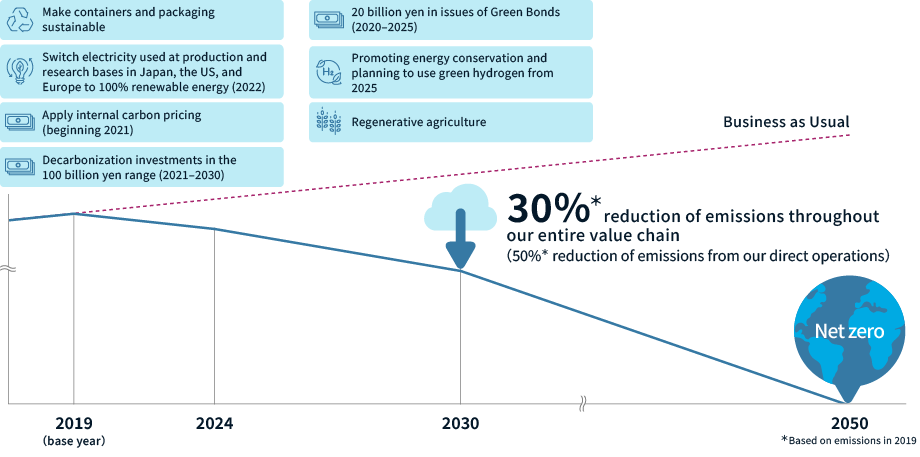
For details on our activities regarding each materiality, see below.
| Key issues | Relevant page |
|---|---|
| Water | |
| Raw ingredients |
Sustainable Procurement Suntory Group’s Sustainability Suntory |
| Climate action | |
| Containers and packaging |
Packaging & Resource Efficiency Suntory Group’s Sustainability Suntory |
Key Initiatives in Transition Plan (1)
Water Replenishment Activities and Awareness Raising involving Local Communities and Other Stakeholders
Stakeholder Engagement :
- Community
- Value Chain
- Government Policy
Forest Management and Water Resource Replenishment based on Scientific Knowledge
Water is Suntory Group's most important raw ingredient and a precious shared resource with local communities. Suntory Group has been conducting the Suntory Natural Water Sanctuary initiative since 2003 to replenish high-quality groundwater in the water source areas of our plants in Japan and to conserve and revitalize forests and biodiversity. Since 2019, the Group has achieved water positivity, replenishing more than twice the amount of groundwater withdrawn by our plants in Japan.
Suntory Group regards this initiative as a part of our core business, rather than a volunteer activity, and is carrying out forestry development with the following goals in mind:
- Forests with a great capacity for conserving and restoring water resources
- Forests rich in biodiversity
- Forests able to withstand flooding and landslides
- Forests with great CO2 absorption capabilities
- Beautiful forests where visitors can encounter nature in all its abundance
Forests that nurture pristine groundwater are also rich in biodiversity. When the inherent forest functions are restored, the flora and fauna also begin to thrive in new ways. Suntory Natural Water Sanctuaries are managed systematically through continuous monitoring of the ecosystem, which includes plants, birds, and other wildlife.
Specifically, considering how wild birds are a barometer of environmental health, we have experts conduct a wild bird survey every year to furnish a broader understanding of the changes taking place in the entire supporting ecosystem. At all Suntory Natural Water Sanctuaries in Japan (26 locations), we are carrying out an Eagles/Hawks Rearing Support Project to support the nesting and breeding of birds of prey, including eagles and hawks, which are at the top of the ecological pyramid. The aim is to continue maintaining forests rich in biodiversity by monitoring the sanctuaries from a bird's perspective.
In addition, when planting trees in Suntory Natural Water Sanctuaries, we collect seeds from the surrounding forests to grow locally-sourced seedlings with careful attention to their DNA in order to avoid any negative impact on biodiversity.
In promoting these activities, we conduct research based on the latest hydrological knowledge by the Institute for Water Science, a specialized water research institute within Suntory Group. We also work with researchers and experts in water, forests, biology, development, soil, and other fields, as well as local residents, to carry out ongoing activities based on scientific evidence with an eye toward the next 100 years.
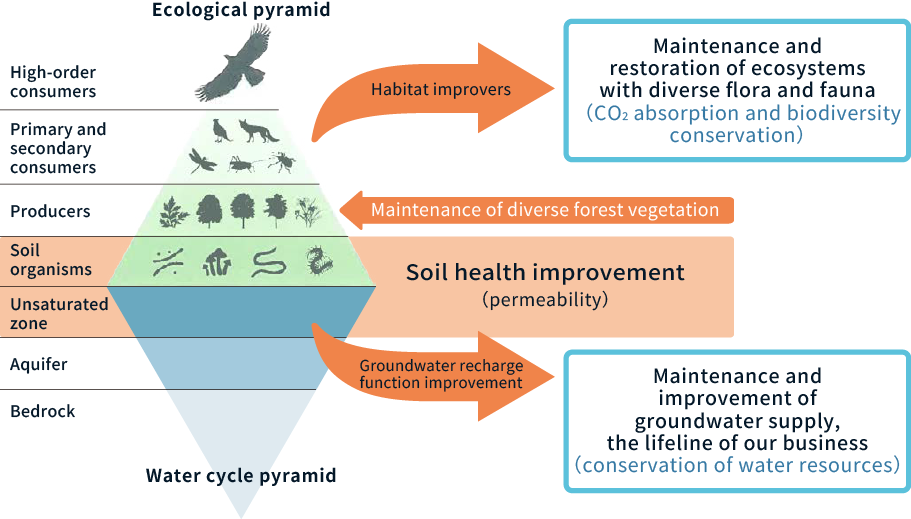
Additionally, 6* Suntory Natural Water Sanctuaries (covering a total of 2,776 hectares) have been certified as Sites Coexisting with Nature promoted by the Ministry of the Environment as part of an initiative aimed at achieving 30by30 goals (which seeks to conserve and protect at least 30% of land and ocean areas by 2030). (As of July 2025)
- *Hyogo Nishiwaki-Monryusan, Tokyo Akigawa, Shizuoka Oyama, Nikko Kirifuri, Ohmi, and Akagi
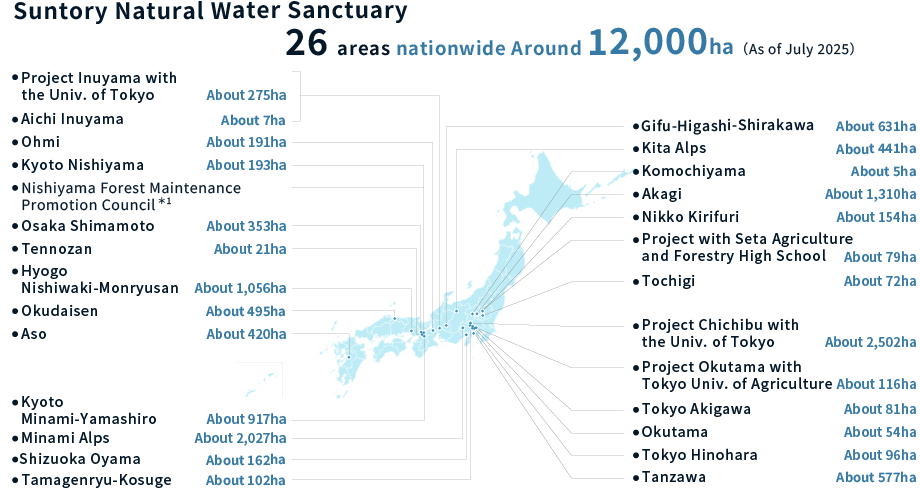
-
*1In Nagaokakyo, Kyoto, we are a member of the Nishiyama forestry development promotion committee and we are cooperating in local forest preservation activities with people in the community. The area of the forests subject to this activity is not counted as part of our total Natural Water Sanctuary area.
Suntory Mizuiku - Education Program for Nature and Water
Suntory Group has been implementing Mizuiku - education program for nature and water since 2004. The program is unique to Suntory Group and designed for the next generation to realize the beauty of nature and the importance of water and the forests that nurture groundwater. It also inspires students to think about what each of them can do for water sustainability. Mizuiku is currently deployed in 8 countries, with cumulative number of participants exceeding 1,190,000 (as of December 31, 2024). Because water issues vary from region to region, Mizuiku programs are customized with the cooperation of NGOs and local governments in each country.
Evaluations on Sustainable Water Use from Certification Bodies
Suntory Group's efforts to address water issues throughout the entire watershed in collaboration with stakeholders such as local governments, NGOs, educational institutions, and local residents have been recognized with the Alliance for Water Stewardship (AWS) certification*, with Suntory’s Kyushu Kumamoto Plant, Okudaisen Bunanomori Water Plant, and Suntory Minami Alps Hakushu Water Plant receiving the highest Platinum certification. Suntory Group is the only Japanese company to have received Platinum certification.
- *The Alliance for Water Stewardship (AWS) is an organization globally promoting water sustainability established by NGOs, such as the World Wide Fund For Nature (WWF), The Nature Conservancy (TNC), and companies. The AWS Certification is an international certificate for sustainable water use targeting plants globally and aims to promote water stewardship.
Water Resource Replenishment and Conservation Activities Around the World
Currently, Suntory Group is promoting water resource replenishment and conservation activities at 33 locations* in 8 countries around the world, including Japan. In Scotland, we are promoting the Peatland Water Sanctuary project to ensure the sustainability of peat, essential for whisky production, while also conserving and restoring peatlands, which are also important water resources. We plan to invest more than 4 million U.S. dollars in the restoration of 1,300 hectares of peatlands by 2030 and to restore peatland that can create twice the amount of peat that Suntory Group uses by 2040.
In this way, our efforts to protect water, the lifeline of business, and the nature that nurtures it, are spreading throughout the world.
- *26 locations in Japan and 7 overseas

Case Studies of the Landscape Approach
Suntory Group practices a landscape approach* to effectively address environmental issues by involving relevant stakeholders.
- *The landscape approach is a method for finding solutions to problems by comprehensively dealing with diverse human activities and the natural environment in a certain region or space, based on land and spatial planning.
Japan: Groundwater Conservation Activities in Kumamoto City
Kumamoto City, the location of the Kyushu Kumamoto Plant, is a fertile region known for its abundant groundwater and greenery. All of the city’s tap water is sourced from groundwater. However, in recent years, concerns have been raised about reduced groundwater replenishment and increased risk of flooding due to the conversion of farmland and other forms of land associated with large-scale urban development and the construction of plants. For this reason, it has become even more important to promote the conservation of the water cycle (water positive) and the regeneration and conservation of the natural environment that supports it (nature positive) throughout the region.
Since 2003, Suntory Group has been working on water replenishment through forest management at Suntory Natural Water Sanctuary Aso. We have also been conducting groundwater replenishment activities called "winter water paddies" that integrate the region’s mountains, rivers and rice paddies. This represents a new attempt at water replenishment, which involves increasing the flow of rivers in the winter by improving the upstream forests and rivers, and then allowing that water to penetrate underground through the water paddies on the alluvial fan. To convert the water paddies to organic farming, we are also working with local farmers to develop technologies that revive the diverse organisms living in the fields that also help to reduce damage from pests and diseases. Additionally, we are working on community-based initiatives, such as conducting surveys of the wildlife in water paddies together with local elementary school students.
In March 2025, 6 organizations, including Suntory Holdings, launched Kumamoto Water Positive Action as a collaborative initiative involving industry, academia, and finance that aims to preserve Kumamoto's water cycle. Using green infrastructure such as rain gardens and winter water paddies, the initiative promotes groundwater replenishment, mitigation of inland and external flooding, measures against the heat island effect, and improvement of landscapes and biodiversity.
- Winter Water Paddies/Activities Policy and Systems/Suntory Natural Water Sanctuary

- Water Cycle Conservation Event held in Kumamoto through collaboration between Industry, Academia and Finance: Launching of Kumamoto Water Positive Action with the Spread of Green Infrastructure February 27, 2025 News Release Suntory

Mexico: Charco Bendito Project
In the country-level water stress assessments where the Suntory Group's plants are located, Mexico was one of the countries with high water stress. Casa Sauza, Suntory Group’s tequila producer, is working on water replenishment activities as a partner company of the Charco Bendito project in Mexico. This watershed initiative is a collaboration with the Beverage Industry Environmental Roundtable (BIER) and 13 other manufacturing companies working to restore ecology and forests in the Lerma-Santiago River watershed through reforestation, soil conservation, and aquifer recharge activities.
This project works with local communities to provide drinking water to local residents without access to water. It also supports local sustainable agriculture and forestry employment through beekeeping and honey production, and protects important community heritage areas.
Key Initiatives in Transition Plan (2)
Promotion of Sustainable Agriculture, including Regenerative Agriculture
Stakeholder Engagement :
- Community
- Value Chain
According to the Food and Agriculture Organization of the United Nations (FAO), around 30% of the world's total GHG emissions originate from the food system, with agricultural production accounting for more than 40% of that. Reducing GHG emissions from agricultural crops, a bounty of nature essential to Suntory Group's products, is important in reducing GHG emissions throughout Suntory Group's entire value chain. Climate change is also expected to have a significant impact on the production activities of our agricultural raw ingredients, including fluctuations in yields and shifts in suitable cultivation areas. Therefore, promoting research and development for sustainable agriculture and breeding that is resilient to climate change is essential for the business continuity of Suntory Group.
From this perspective, Suntory Group is working with trading companies, farmers, local experts and others to promote sustainable agriculture, including regenerative agriculture*. In particular, regenerative agriculture, which has been introduced in the cultivation of corn, barley, sugar cane, and other crops, is expected to reduce GHG emissions through farming methods such as the use of cover crops and no-till farming. At the same time, it will regenerate soil biodiversity, make the soil more fertile, reduce the use of chemical fertilizers and pesticides, and enable the more efficient use of water.
Additionally, for the cultivation of key raw ingredients (i.e., coffee beans, barley, and grapes) that require large amounts of water in water-stressed regions, we are working with suppliers to improve water-use efficiency.
Coffee beans are considered to have a high environmental impact and human rights risk. As a result, we procure some of our coffee beans from Fazenda Bau Farm in Brazil, which has received international sustainability certification. We also work with trading companies and local partners to promote programs to support the coffee farmers we do business with, identify and correct any issues, and take other measures, while also taking into consideration the human rights of people working in the value chain.
- *Regenerative agriculture: An outcome-based approach to agriculture that protects and improves soil health and biodiversity while also contributing to improving the livelihoods of farmers.
Raw Ingredients and Production Areas of Sustainable Farming
| Business | Ingredient | Producing country |
|---|---|---|
| Non-alcoholic beverage | Coffee beans ★ | Brazil, Guatemala, and Uganda |
| Alcoholic and non-alcoholic beverage | Corn ★ | USA |
| Alcoholic and non-alcoholic beverage | Barley ★ | UK |
| Alcoholic and non-alcoholic beverage | Sugarcane ★ | Thailand |
| Alcoholic Beverages | Agave ★ | Mexico |
| Non-alcoholic beverage | Blackcurrant ★ | UK |
| Non-alcoholic beverage | Grape | Japan |
Sustainable Procurement Suntory Group’s Sustainability Suntory
Key Initiatives in Transition Plan (3)
Initiatives to Achieve PET Bottles Made from 100% Recycled or Plant-based Materials
Stakeholder Engagement :
- Community
- Value Chain
- Industry
- Government Policy
Plastics have enriched our lives through their usefulness. On the other hand, the environmental impact caused by improper handling of used plastics has become a problem.
To powerfully lead the transition to a circular and net-zero society, Suntory Group is advancing activities to switch all of the PET bottles we use worldwide to be made of 100% recycled or bio-based materials by 2030, completely eliminating the use of virgin petroleum-based materials.
Based on Suntory Group's own 2R+B (Reduce, Recycle + Bio) strategy, we are working to thoroughly make effective use of resources by reducing resin use and using recycled or bio-based materials, while replacing petroleum-based materials with renewable ones.
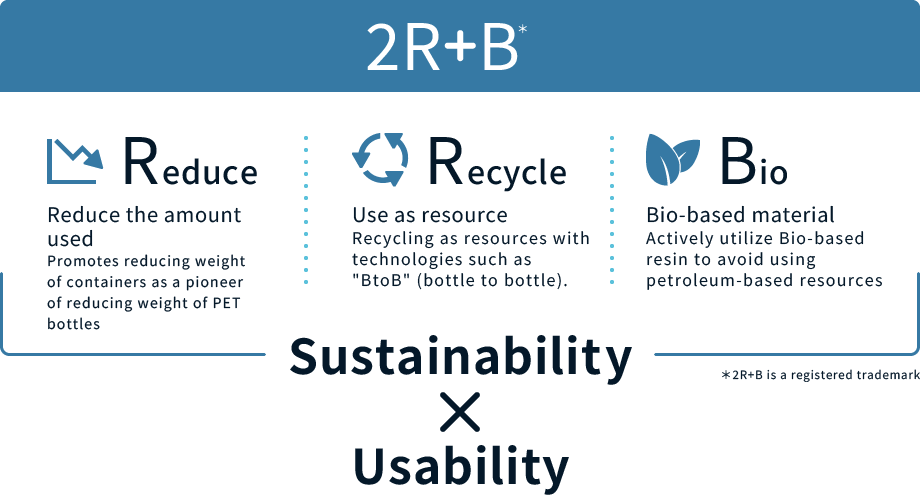
Promotion of “Bottle to Bottle” Horizontal Recycling
“Bottle to bottle” horizontal recycling recycles PET bottles many times, using them as a resource, which can help reduce the use of virgin petroleum-based materials and CO2 emissions. “Bottle to bottle” horizontal recycling using a mechanical recycling*1 technique is the recycling method with lower environmental impact (lower CO2 emissions throughout the process, from raw materials procurement to PET preform production) compared to chemical recycling*2. Therefore, we prioritize "bottle-to-bottle" horizontal recycling, aiming to realize a sustainable society by repeatedly reusing PET bottles as resources.
In order to promote the resource recycling of PET bottles in Japan, we have concluded agreements on “bottle to bottle” horizontal recycling with local governments, distribution companies and others, under which we are collecting used PET bottles and recycling them into new ones. Because horizontal recycling requires the understanding and cooperation of consumers, we hold events to raise awareness among consumers and provide educational outreach classes on PET bottle recycling at elementary and junior high schools in partner municipalities.
Initiatives for Recycling Used Plastic
In 2020, Suntory Group established R Plus Japan Ltd., a joint venture together with 12 companies (including Suntory) in the supply chain to engage in the recycling of used plastics. As of March 2025, the number of participating companies has expanded to 48, and together with Anellotech, a bio-chemical venture firm in the United States, we are developing technologies to recycle used plastics.
Packaging & Resource Efficiency Suntory Group’s Sustainability Suntory
- *1Mechanical recycling system: A method in which recycled resin obtained through material recycling (where used PET bottles are crushed, washed and otherwise processed into materials to make more PET bottles) is further processed under high temperature and reduced pressure for a certain period of time to remove impurities in the recycled material and make PET resin of suitable quality for beverage containers.
- *2Chemical recycling: A method of chemically breaking down plastics into their original raw materials and monomers, and then reusing them.
Key Initiatives in Transition Plan (4)
Realizing Plants with Effectively Zero GHG Emissions by Using Green Hydrogen
Stakeholder Engagement :
- Community
- Value Chain
- Government Policy
In our Environmental Targets toward 2030, Suntory Group has set a goal of reducing GHG emissions from our owned business sites by 50% compared to 2019. Currently, we use 100% renewable energy for electric power purchased at all alcohol beverage, non-alcohol beverage and food manufacturing sites and R&D facilities in Japan, the Americas, and Europe.
Furthermore, we plan to install a 16-megawatt power to gas (P2G) system, the largest in Japan, at the Suntory Minami Alps Hakushu Water Plant and Suntory Hakushu Distillery by 2025. The system will utilize electricity derived from solar power and other renewable energy sources, making it capable of producing “green hydrogen” without emitting CO2 during the hydrogen production process.
With the introduction of this system, we plan to work with Yamanashi Prefecture to explore the conversion of fuel for thermal energy used in plants, such as the steam used in the sterilization process at the Suntory Minami Alps Hakushu Water Plant, to green hydrogen, as well as the use of green hydrogen in the surrounding communities.
- *Green hydrogen: Hydrogen produced without emitting CO2 by using electricity generated using renewable energy such as solar power when electrolyzing water in the production process.
For details, see the news release Suntory Announces Suntory Green Hydrogen Vision.![]()
Financial Strategy
Investment Plan for Decarbonization
Suntory Group plans to invest 100 billion yen from 2021 to 2030 to promote decarbonization. These investments are expected to reduce GHG emissions by approximately 1 million tons in 2030.
Internal Carbon Pricing
Suntory Group has been using internal carbon pricing since 2021. Internal carbon pricing is widely used in making management decisions, mainly capital investment decisions contributing to climate change countermeasures.
<ICP Summary of Suntory Group>
| Price | 8,000 yen per ton |
|---|---|
| Approach | Shadow price |
| Scope | Internal Suntory Group |
| Prerequisites for price calculation | Calculated based on forecasts by the International Energy Agency (IEA) and other international organizations, benchmarks used by other companies in the industry and those promoting advanced environmental initiatives, as well as evaluation of past internal decision-making. |
Financing
Suntory Group raised 20 billion yen using green bonds in 2023. Going forward, these funds will be utilized for the following purposes up to 2025.
- Energy efficiency
- -Capital investment contributing to energy-saving at the plants we own
- Renewable energy
- -Costs for procurement of green hydrogen
- -Capital investment for the construction of biogas refining facilities, biomass heat supply facilities or biomass power generation facilities through wastewater treatment
- -Costs for procurement of electricity generated from renewable energy (purchase of renewable energy certificates)
Managing Risks and Impacts
Risk Management System
At Suntory Group, the Global Sustainability Committee identifies, assesses, and manages risks and opportunities related to sustainability. The Global Risk Management Committee regularly identifies and assesses risks within Suntory Group, identifies risks that should be addressed as a priority for Suntory Group, and promotes risk mitigation activities Group-wide. Sustainability-related risks are also included in the scope of the Committee’s activities. The results of these activities are reported to the Board of Directors on regular basis. Nature capital-related risks and climate change-related risks are considered to be among the most important risks and the status of responses are monitored within this process.
The process of identifying and assessing risks and opportunities incorporates the collection of external information, such as that on the external environment and in risk reports, as well as interviews with executives. The identified risks and opportunities are then assessed according to "risk exposure (likelihood of occurrence x impact)" and "management preparedness (degree of preparation for countermeasures)," to identify those risks and opportunities to be prioritized.
To identify and manage risks in operations, we use the Sedex* platform to assess environmental and human rights risks at our suppliers and our own plants. In turn, we encourage corrective action when issues are identified. As a relief system, we have established an internal reporting system for employees. We also have in place the Suntory Group Business Partner Compliance Hotline and Customer Center as reporting channels that can be accessed by suppliers and other stakeholders (community members).
- *Sedex: An NPO that works to improve ethical business practices in global supply chains by providing a platform where member companies can share their own ethical and value chain information.
For more information on human rights risk assessments and response status, see below.
Respect for Human Rights Suntory Group’s Sustainability Suntory
Organizational Chart

Method of Managing Identified Risks
For risks identified to require priority response, we appoint a person in charge and a monitoring organization and then implement measures to address the risks. The status of responses is reported and discussed at the Global Risk Management Committee (GRMC). Key risks for the next fiscal year are selected based on the results of the responses, followed by the PDCA cycle of identification, evaluation, countermeasures, and monitoring.

Indicators and Targets
Suntory Group has established Environmental Targets toward 2030 in addition to our long-term Environmental Vision toward 2050, covering water and climate action, which are expected to have a particularly large impact on our business operations among sustainability issues. We have also set goals for containers and packaging toward 2030 and are currently taking action accordingly.
| Materiality | 2030 targets | 2024 results | |
|---|---|---|---|
| Water |
Reduction of water used in direct operation |
Reduce the water intensity of production at our owned plants*1 by 35%*2 globally. In addition, explore reduction of absolute amount of water withdrawn in highly water stressed areas |
|
Water replenishment |
Replenish more than 100% of water used in at least 50% of our owned plants*1 globally, including all those in highly water stressed areas, through local water source conservation efforts. Especially in regions with high water stress, the above initiatives are implemented at all plants. |
|
|
Sustainable water use in raw ingredients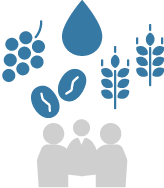 |
Collaborate with suppliers to improve water-use efficiency in the production of water-intensive key ingredients*3 in highly water stressed areas. |
|
|
Water education and access to safe water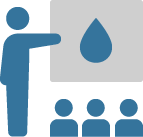 |
Expand water education programs and initiatives to provide safe water access for more than 5 million people. |
|
|
| Climate action |
Scope 1,2

|
Reduce GHG emissions from our direct operations by 50%*4 |
|
Scope 1,2,3

|
Reduce GHG emissions across our entire value chain by 30%*4 |
|
|
| Containers and packaging |
Use of Sustainable Materials in PET Bottles |
100% of PET bottles made with sustainable materials (globally) |
|
-
*1Suntory Group plants that manufactures finished products
-
*2Reduction of water intensity of production based on 2015 baseline year
-
*3Coffee beans, barley, grapes
-
*4Based on emissions in 2019.
-
*5Percentage of sustainable materials (e.g., recycled or bio-based materials) in terms of PET bottle weight.
Contributing to Achievement of Targets set out in the Kunming-Montreal Global Biodiversity Framework
Suntory Group will contribute primarily to achieving the following 9 of the 23 global targets for 2030 set out in the Kunming-Montreal Global Biodiversity Framework, containing global targets for biodiversity adopted at the 15th Conference of Parties to the UN Convention on Biological Diversity (COP15).
| 1. Reduce threat to biodiversity | Suntory Group’s main contributions | |
|---|---|---|
| Target 2 | Restore ecosystems |
|
| Target 3 | 30by30, protected areas and OECM (other effective area-based conservation measures) |
|
| Target 7 | Prevent pollution as well as halve loss of nutritive salts and risks of pesticides |
|
| Target 8 | Climate change countermeasures |
|
| Target 9 | Social, economic and environmental benefits to people, especially those in vulnerable situations and those most dependent on biodiversity |
|
| 2. Satisfy people’s needs | ||
| Target 10 | Sustainable management of agriculture, forestry and fisheries |
|
| Target 11 | Restore, maintain and enhance nature’s contributions to people through an approach using solutions or ecosystems using nature |
|
| 3. Tools and solutions for implementation and mainstreaming | ||
| Target 15 | Businesses assess and disclose impacts |
|
| Target 16 | Sustainable consumption |
|
TNFD Core Disclosure Metrics Response Chart
| No. | Impact drivers | Metrics | Details of metrics |
|---|---|---|---|
| - | GHG emissions | ||
| C1.0 | Land/freshwater/ocean-use change | Total spatial footprint |
|
| C1.1 | Land/freshwater/ocean-use change | Land/freshwater/ocean-use change |
|
| C2.0 | Pollution/pollution removal | Pollutants released to soil split by type |
|
| C2.1 | Pollution/pollution removal | Wastewater volume and water quality |
|
| C2.2 | Pollution/pollution removal | Waste volume |
|
| C2.3 | Pollution/pollution removal | Waste plastic amount |
Waste plastics
|
| C2.4 | Pollution/pollution removal | Non-GHG air pollutants |
*Production sites in Japan only |
| C7.2 | Risks | Description and value of significant fines/penalties received/litigation action in the year due to negative nature-related impacts |
|
| C7.3 | Opportunities | Amount of capital expenditure, financing or investment deployed toward nature-related opportunities (by type) |
|
| C7.4 | Opportunities | Increase and proportion of revenue from products and services producing demonstrable positive impacts on nature |
|
- *For 2024, data covers 79 plants in the Group, including 27 production sites in Japan and 52 production sites overseas
